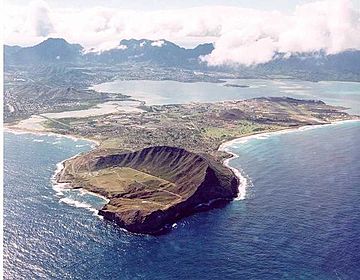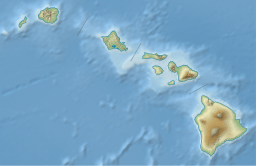Ulupaʻu Crater facts for kids
Quick facts for kids Ulupaʻu Crater |
|
|---|---|

Aerial view of Ulupaʻu Crater and the rest of the Mokapu Peninsula
|
|
| Highest point | |
| Elevation | 659 ft (201 m) |
| Geography | |
| Location | Honolulu County, Hawaii, United States |
| Geology | |
| Mountain type | Tuff cone |
| Last eruption | 600,000 - 400,000 years ago |
Ulupaʻu Crater is a special kind of volcano in Hawaii. It is also known as Ulupaʻu Head. This crater is found near Marine Corps Base Hawaii on the Mokapu Peninsula. It is a tuff cone, which is a volcano shaped like a cone. Tuff cones are made from volcanic ash and rock pieces. These pieces explode out of the ground.
Contents
What is Ulupaʻu Crater?
Ulupaʻu Crater is a tuff cone. A tuff cone is a type of volcano. It forms when hot magma mixes with water. This creates steam explosions. These explosions throw out ash, rock, and volcanic debris. This material then builds up around the vent. Over time, it forms a cone shape. Ulupaʻu Crater stands about 659 feet (201 meters) tall.
How Ulupaʻu Crater Formed
Ulupaʻu Crater was created by the Honolulu Volcanic Series. This was a series of volcanic eruptions. These eruptions happened a long time ago. They were part of the Koʻolau Range's "rejuvenation stage." This means the volcano became active again. It erupted after a long period of being quiet.
The Honolulu Volcanic Series formed many volcanoes. One famous example is Diamond Head. Ulupaʻu Crater formed between 600,000 and 400,000 years ago. This makes it a very old geological feature.
Changes to the Crater Over Time
Over many years, the eastern part of Ulupaʻu's rim has changed. It was worn away by something called erosion. Erosion happens when wind and water slowly break down rocks and soil. This process reshapes the land. It can make parts of a volcano disappear.
Nearby Volcanoes
There is another small volcano nearby. It is called Puʻu Hawaiʻiloa. This volcano is a cinder cone. A cinder cone is also a type of volcano. It is usually smaller than a tuff cone. Cinder cones are built from lava fragments. These fragments are called cinders. They erupt from a single vent. The cinders cool quickly and pile up. They form a steep, cone-shaped hill. Puʻu Hawaiʻiloa is located on the same Mokapu Peninsula as Ulupaʻu Crater.


